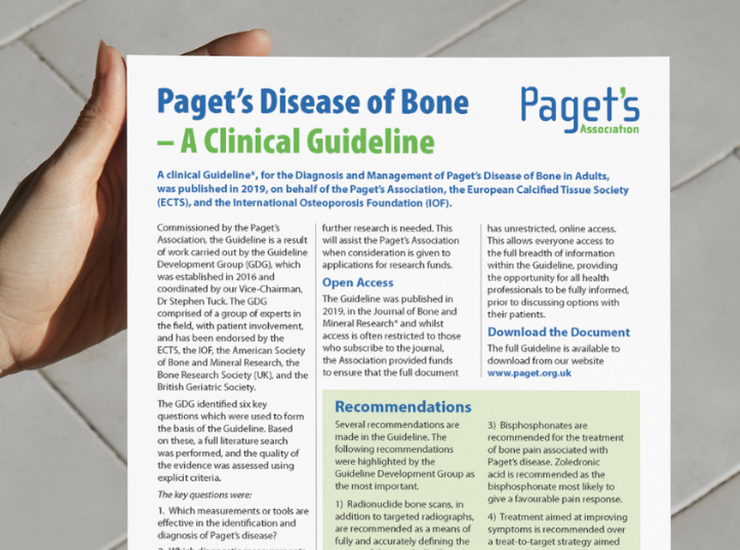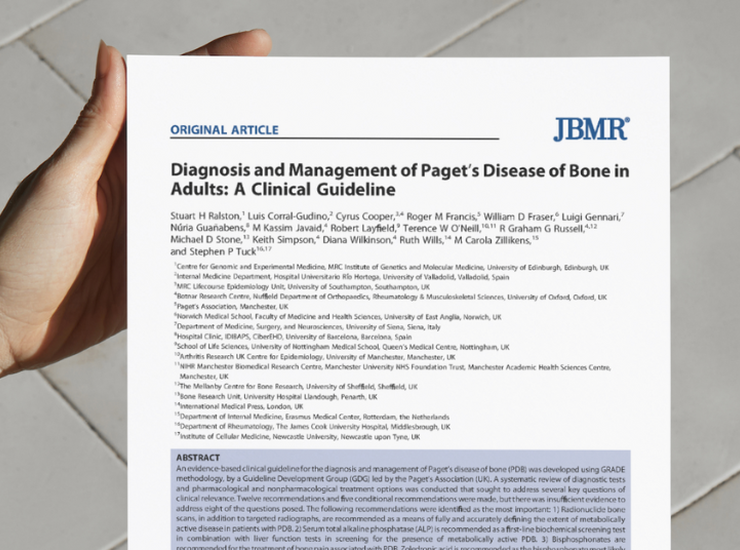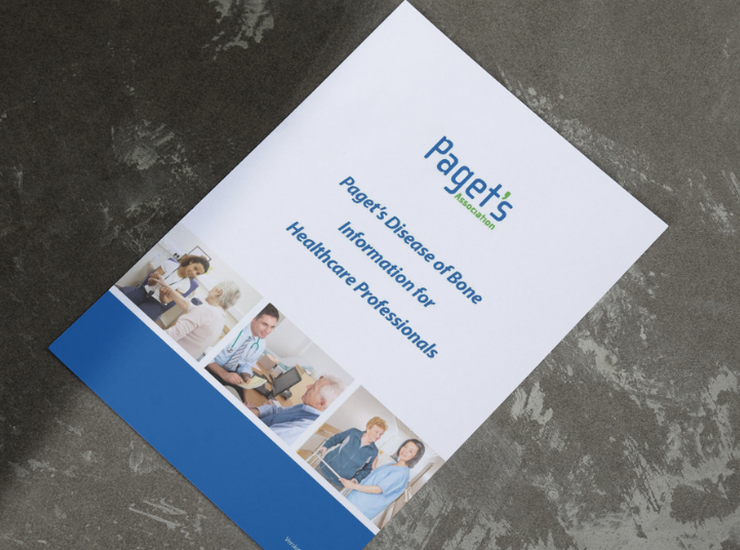Professional resources
Below, you can find resources for healthcare professionals and researchers with an interest in Paget's disease.
Recent papers
Follow this link for a news feed of recently published articles from PubMed.
Paget's clinical guideline, case studies and more
A clinical guideline, for the diagnosis and management of Paget’s Disease of Bone in adults, was commissioned by the Paget's Association, with the support of the European Calcified Tissue Society and the International Osteoporosis Society. The full Guideline was published in the Journal of Bone and Mineral Research. You can download the guideline in full or a summary below.
Case studies are include in our Healthcare Professional booklet as well as information regarding assessment, diagnosis and treatment. You can download it below. Hard copies are also available.

Clinical Guideline - Summary
A clinical Guideline, for the Diagnosis and Management of Paget’s Disease of Bone in Adults, which assists health professionals to consider the evidence and discuss options with t…
PDF 1.2mb

Clinical Guideline - Full
The full clinical guideline for the Diagnosis and management of Paget's Disease of Bone in Adults
PDF 2.8mb

Paget's Disease - Information for Professionals
Case studies, diagnosis, management and more can be found in this booklet for all healthcare professionals caring for those affected by the condition
PDF 1.3mb
Prof Mike Stone discusses the clinical guideline below
When to refer to a specialist
An article in the British Journal of General Practice discussed when and why to refer to a consultant. The authors explain that the most common presentation of Paget’s disease is with bone pain, deafness, or fractures caused by the disease. In about one-fifth of patients, however, it is an incidental finding when a blood test or x-ray is carried out for another reason. They advise that when there is pain or deformity due to Paget’s disease, a referral to a specialist should be considered to enable further assessment to be carried out and treatment to be offered if appropriate. Read the full article here
Reference: Nairn, C and Ralston, S.H., ‘Paget’s disease of bone: when and why to refer to specialist care’, British Journal of General Practice; 2020, 70: 561-562
Commonly missed and poorly understood
Providing an overview of the condition, the article, ‘Adult Paget’s Disease of Bone’, was published in ‘Clinical Medicine’. It provided an overview of Paget’s disease, including diagnosis, treatment, complications, and monitoring. The authors explain that when zoledronate is given, it can be effective for years, however, an annual follow-up appointment is required to assess for relapse and potential complications. They conclude that Paget’s is, “commonly missed and, even when identified, it is poorly understood and inadequately treated, despite the efficacy of bisphosphonates.” Read the full article here.
Reference: Tuck, S.P., Walker, J., ‘Adult Paget’s Disease of Bone’, Clinical Medicine, 2020, vol 20, no 6: 1-4.
Diagnosis and management
The authors of an article published in The Practitioner point out that the three main risk factors for Paget’s disease are age, male gender and family history. They provide a suggested pathway for referral to a consultant and comment on the three currently licensed (in the UK) bisphosphonates for the treatment: zoledronate (generally considered first choice and most likely to give a favourable pain response), risedronate and pamidronate. They also comment that following successful treatment, pain may recur even if the alkaline phosphatase level is not elevated, therefore the patient should be referred back to the consultant for evaluation.
Download the PDF
Reference: Nairn, C and Ralston, S.H., Diagnosis and Management of Paget’s Disease of Bone. The Practitioner, 2020, Nov 2020;264(1842):11-15.
Treatment for Paget’s Disease
In the journal ‘Bone’, Professor Stuart Ralston looked in detail at bisphosphonates, explaining that bisphosphonates are the treatment of choice for Paget’s disease, with zoledronate the bisphosphonate most likely to ease pain. Looking towards the future he discussed how many people who have Paget’s disease do not have pain, even when there is increased bone turnover, therefore, more research is needed to find out why this is the case. Research is also needed into the effects of bisphosphonates on complications such as deformity, fractures and deafness. He discussed several research studies (PRISM and PRISM-EZ, investigated the long-term effects of bisphosphonates in those with established Paget’s disease. They showed that intensive bisphosphonate therapy aimed at normalising the level of alkaline phosphatase in the blood was no more effective for preventing complications than treatment given to those who had symptoms. The Zoledronate in the Prevention of Paget's Disease (ZiPP) trial, which is currently in progress, seeks to determine whether early intervention with zoledronate might be effective in preventing disease progression. If the study shows beneficial effects, genetic testing, together with early bisphosphonate therapy, might be used in the future. Read the full article here
Reference: Ralston S.H., ‘Bisphosphonates in the management of Paget's disease’, Bone, 2020, Sep;138:115465.

